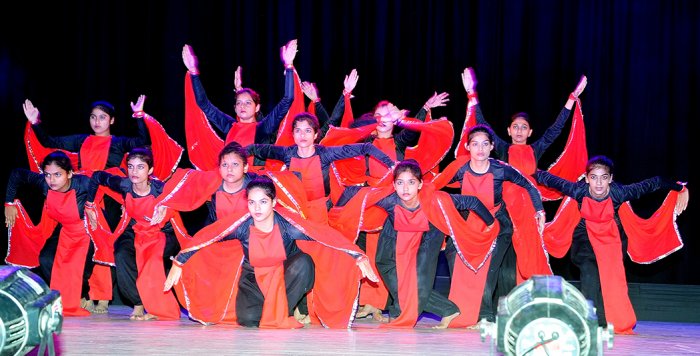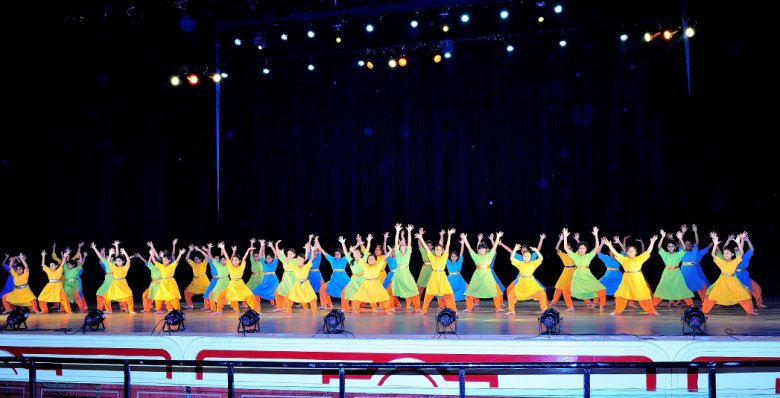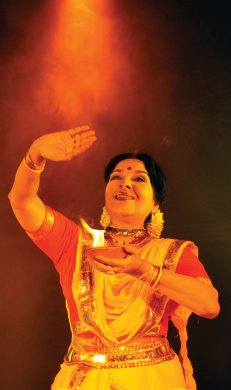
|   |

|   |
 e-mail: ukb7@rediffmail.com Post Uday Shankar, any which way? Photos courtesy: Udayan Kala Kendra October 28, 2017 The iconic contemporary dancer Uday Shankar came into his destined vocation almost fortuitously. As a fresh youth of 21, he had gone to London to join William Rothenstein (1872-1945) to learn painting, when the great British master advised him to look at traditional Indian paintings first, at the British museum. This was to let him gain an Indian insight, since his exposure to his country's culture was limited, till then, to the lakes and palaces of his birth-town Udaipur, and temples and river banks of Banaras, his maternal uncle's place. Soon, he was spotted - for his handsome physique and visage - by the legendary ballerina Anna Pavlova who offered him a partnership in a couple of dances with her at Covent Garden. When, later, Shankar expressed keenness to join her troupe for a permanent career in ballet, Pavlova firmly turned his mind back to his own country and urged him to study the heritage of Ajanta and Ellora in the first place. Shankar did so, opened his own dance group to conquer the world and, in a nutshell, a star was born. To him, till the very end, dance remained a philosophy and a way of life. After witnessing his public performances a few times in Patna, Kolkata and Jamshedpur in that order, it was fascinating for this critic to hear him speak out his love of nature in a rare private reception in the Steel City. After a young maiden's dance to felicitate him - to the tune of Tagore's famous song: Remove all shackles, O Nataraj, with the rhythms of your dance..., done on a specially flower bedecked floor - he quietly observed, "Rather than see her perform, I was moved to see how the breeze was stirring the flower petals to and fro; that was the real dance to me..."  Prayas 2017 presented recently by Udayan Kala Kendra, at the spacious Science City in Kolkata, was a brave effort to carry the mantle of Uday Shankar - in a journey of 31 years - under the baton of his gifted daughter Mamata Shankar. The two-day festival was an annual gala with presentations by the very large number of students, following roughly the same sequence of songs and melodies on both the days but the participants were different. Since these presentations came from different age groups, the quality did waver from one age bracket to another. But the choreographic efforts of the teachers - who followed the laid down method assiduously under Mamata Shankar's overall guidance - were entirely praiseworthy. Both evenings began with Tagore's kinship with Nature: The sky dazzles with the sun and planets, earth bristle with life... and some 60-upward tiny tots woke up - like seedlings from slumber - to sprout in the air and quiver in delightful wonder. On both days, it was an amazing experience. The second song was a Tagore Brajabuli (broken Maithili) original: Sajani sajani Radhika lo, dekho abahun chahiya... and a chaste Manipuri dance by a large group on each evening suited the theme quite well. The third item was yet another Tagore favourite: I've no inhibition to get lost anywhere, in my own mind... and the children on both days were led to emote, with great energy, for a foray into the never-never land. Beauty of Nature was, for a change, a musical orchestration by Shankar's hugely talented son Ananda Shankar - whom the land lost in the early bloom of his life - on the first evening and Dance of Joy, another of his fusion compositions on the second evening. Senior students visualized the haunting melody in riotous colour costumes each day. There was a Kathak interlude on both evenings conducted competently by the veteran Sandeep Mallick. A refreshing addition was the Japanese composer Kitaro's musical filigree Fujiyama - very largely following the minimalist tradition - on both evenings, interpreted joyously by seniors in an entirely modern style. Many would have seen already on stage Ajay Atul's brilliant Marathi composition Apsara aali.., danced by either Madhuri Dixit or Sonali Kulkarni or traditional Lavani dancers. This favourite was taken up by the Advance Group with vivacious joy.  There were also two dance-dramas, both with music by Dipak Chowdhury and executed by a large assortment of dancers, offering ample glimpses of the Shankar style. Shikar on the first evening was an allegorical tale, of freely romping forest deer exhibiting delicate emotions of social bonding and fellow feeling, sharply contrasted by the ill behaved humans, who had come to the woods for a picnic and proceeded to slaughter the deer in uninhibited glee. While the deer came through well (but for some confusion in costumed ears and horns), the picnickers could have benefitted with some choreographic input. Milap on the second evening was more elaborate and ambitious, building in Hindu-Muslim amity, clash of agriculture and industry, social forbearance and so on. In the process, it became a mixed-up affair, with a labour-and-machinery dance, seemingly lifted out of the Shankar film Kalpana. A more organized story line could have perhaps done better justice to the overall choreography. Extracts from interview with Mamata Shankar:  Mamata Shankar Observing you over the years, one is tempted to feel that you're an intuitive dancer to whom choreography comes from a sixth sense. Is that a right perception? You're absolutely right. I had the chance for only a brief spell of training under Shankar, but was groomed quite long by my mother Amala Shankar who passed on my father's legacy to me. Yes, it's quite true that I don't wear my technique on my shirt sleeve. My choreographic inspiration stirs within and the intellect works accordingly. New ideas then surge. Shankar did not go against gravity like the West nor did he thump the earth like Indian classical dancers. Which school do you follow? Shankar did not use balletic leaps nor intimate body hugging. We follow the same approach and remain firmly grounded on earth. We don't use the Indian classical style of striking the earth either. Shankar's choreography has strong contrasts - horizontal extension and contraction, vertical rise and fall. How do you view them? To me, breathing is important, not touching the floor or rising up. The entire effort should be to let the spectator's mind reach another level. Choreography should have a magical effect and should be absolutely spontaneous, not contrived or laboured. Theme as well as music is most important element here. I try to conceive the music first and let my choreography come along hand-in-hand with music. Music and movement must merge. I allow my theme to select music, and then let all three coalesce: movement, music and theme. The Western dance makes copious use of solar plexus, with breathing in and out, which Shankar did, too, though our classical dancers don't attach great importance to breathing technique. What's your take? To hold breath and to exhale are cardinal features to my dance. Often it's very important to hold breath, sit still and remain totally tranquil, and then open eyes and erupt. This is almost like a volcano! The stillness and subsequent explosion of feelings is an essential part of Shankar's style. Shankar was known for his sinuous movements of upper and lower torso and intimate use of upper and lower levels... To my mind, movements should be rounded. If I've a feeling of grief, I may come down from above and may fall heavily on the floor. On the contrary, if I'm feeling happy, perhaps I'll slowly rise. It all depends on the theme. The movement should eventually touch the audience's heart. How about Shankar's use of diagonal glances and head-tilts? They must, again, be entirely dictated by the theme. Each glace and head-tilt must connect with what I'm trying to express. One more point... I'm particular that for a movement there is always a starting point, and a finishing point, with the trajectory defined by the music. Do you reject ghungroos, as Shankar did? My theory is that they must remain incidental, and never dominate. Otherwise, their sound from the wings or movements behind the back curtain - when the entry of a dancer is from the other side after the exit - can detract attention. Their use on the stage should not be noticeable, but just atmospheric, touching people's mind but not make audible noise. Shankar, with his long exposure to the West, was very keen on professional showmanship. What's your view? Yes, he was dead against shoddiness on the stage, which some classical dances permit here somehow. We pay utmost attention to the visual appeal and take special care to ensure that our presentations cross the barriers of language. For proper showmanship, we keep our sets and props minimal. Shankar was very particular on lighting. We respect his views and use it as much as we can afford. Two last questions: how far do you follow Natya Shastra? I've never studied Natya Shastra. But I'm utterly delighted when I discover that a lot of stances and movements that we use are clearly rooted in that treatise. And how much do you follow the tenets of group choreography laid down in Natya Shastra's 'Pindi Bandhan' section, for instance, the closed chains, the open chains, the converging-arrow formations and diverging-arrow formations - which one even finds in use as far away as Bali Island in their mythological Kechaka Dance? It's really welcome news to me to know that the Natya Shastra provisions were carried so many thousands of miles away by our ancestors. But yes, I've used the kind of group choreography that you mention in my compositions several times, without being aware that they were mandated in Natya Shastra so long ago.  Dr. Utpal K Banerjee is a scholar-commentator on performing arts over last four decades. He has authored 23 books on Indian art and culture, and 10 on Tagore studies. He served IGNCA as National Project Director, was a Tagore Research Scholar and is recipient of Padma Shri. Post your comments Please provide your name and email id when you use the Anonymous profile in the blog to post a comment. All appropriate comments posted with name & email id in the blog will also be featured in the site. |